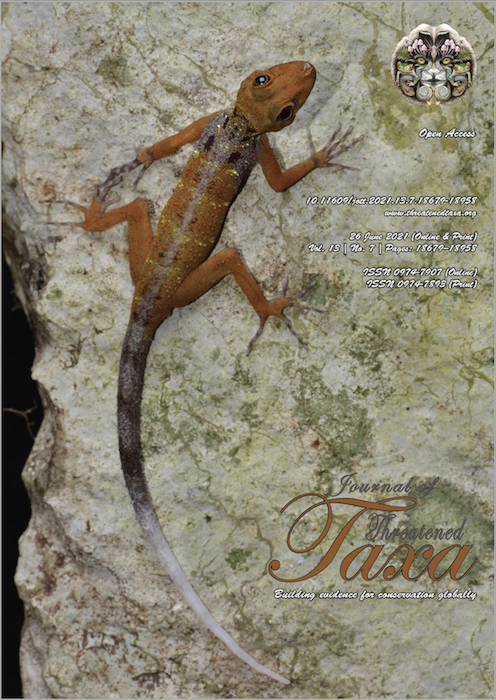Population and conservation threats to the Greater Flamingos Phoenicopterus roseus (Aves: Phoenicopteriformes: Phoenicopteridae) at Basai Wetland and Najafgarh Jheel Bird Sanctuary, Haryana, India
Main Article Content
Abstract
Greater Flamingos are the largest and most widespread, among other species of Phoenicopteridae. This study documents the population structure and conservation threats affecting the population and habitat of the flamingos at Najafgarh Jheel Bird Sanctuary and Basai wetland in Haryana, India. The study areas were surveyed monthly between May 2019 to February 2020 at regular intervals. A Nikon 8 X 40 field binoculars and a Nikon SX60 camera were used to observe flocks of P. roseus. A total of 65 flocks of flamingo were observed, and 6,768 individuals were counted using point counts method. Najafgarh Jheel Bird Sanctuary holds a major proportion of their population comprising about 91.78 % and Basai wetland holds about 8.21 % of their population, while 52.46 % of the total population were classified as adults, and 47.53 % were juveniles (sub-adults). Habitat fragmentation resulting from construction of roads is one of the major threats, while overgrowth of water hyacinth, cattle grazing and fishing activities at Basai Wetland, adversely affected the flamingos. At the Najafgarh Jheel, cattle grazing was considered to be the major threat, followed by the overgrown water hyacinth, fishing activities and collision with high tension power lines.
Article Details

This work is licensed under a Creative Commons Attribution 4.0 International License.
Authors own the copyright to the articles published in JoTT. This is indicated explicitly in each publication. The authors grant permission to the publisher Wildlife Information Liaison Development (WILD) Society to publish the article in the Journal of Threatened Taxa. The authors recognize WILD as the original publisher, and to sell hard copies of the Journal and article to any buyer. JoTT is registered under the Creative Commons Attribution 4.0 International License (CC BY), which allows authors to retain copyright ownership. Under this license the authors allow anyone to download, cite, use the data, modify, reprint, copy and distribute provided the authors and source of publication are credited through appropriate citations (e.g., Son et al. (2016). Bats (Mammalia: Chiroptera) of the southeastern Truong Son Mountains, Quang Ngai Province, Vietnam. Journal of Threatened Taxa 8(7): 8953–8969. https://doi.org/10.11609/jott.2785.8.7.8953-8969). Users of the data do not require specific permission from the authors or the publisher.
References
Ali, S., S.D. Ripley & J.H. Dick (1987). Compact handbook of the birds of India and Pakistan. (Compact edition). Oxford University Press, 841pp.
Allen, R.P. (1956). The flamingos: their life history and survival, with special reference to the American or West Indian Flamingo (Phoenicopterus ruber) (No. 5). National Audubon Society, 285pp.
Arengo, F. & G.A. Baldassarre (1995). Effects of food density on the behavior and distribution of nonbreeding American Flamingos in Yucatan, Mexico. The Condor 97(2): 325–334. https://doi.org/10.2307/1369018
Baldassarre, G.A. & F. Arengo (2000). A review of the ecology and conservation of Caribbean Flamingos in Yucatan, Mexico. Waterbirds 23: 71–79. https://doi.org/10.2307/1522149
Bibby, C.J., N.D. Burgess, D.A. Hill & S.H. Mustoe (2000). Bird Census Techniques. Second edition. Academic Press, London, 302pp.
Bote, M.A., V.R. Naik & K.B. Jagadeeshgouda (2020). Review on water hyacinth weed as a potential bio fuel crop to meet collective energy needs. Materials Science for Energy Technologies 3: 397–406.
Childress, B., S. Nagy, B. Hughes & Y.B. Abebe (2008). International Single Species Action Plan for the Conservation of the Lesser Flamingo (Phoeniconaias minor). CMS Technical Series No. 18. AEWA Technical Series No. 34, Bonn, Germany, 59pp.
Godefroid, S. (2001). Temporal analysis of Brussel flora as indicator for changing environmental quality. Landscape and Urban Planning 52: 883–890.
Gosai, K.R., T.K. Shrestha, S.D. Hill, S.M. Shrestha, B. Gyawali, D.N. Gautam & A. Aryal (2016). Population structure, behavior, and current threats to the Sarus Crane (Grus antigone antigone) in Nepal. Journal of Asia-Pacific Biodiversity 9(3): 301–305.
Grimmett, R., C. Inskipp & T. Inskipp (1998). Birds of the Indian Subcontinent. Oxford University Press Delhi, 480pp.
Islam, M.Z. & A. Rahmani (2004). Important Bird Areas in India: Priority Sites for Conservation. Indian Bird Conservation Network: Bombay Natural History Society and Birdlife International (UK), 1133pp.
Jenkin, P.M. (1957). The filter-feeding and food of flamingoes (Phoenicopteri): Philosophical transactions of the Royal Society of London. Biological Sciences 240(674): 401–493.
Johnson, A.R. & F. Cezilly (2007). The Greater Flamingo. T. & A.D. Poyser, London, 328pp.
Ogilvie, M. & C. Ogilvie (1986). Flamingos. Allan Sutton Publishing Limited, Gloucester, 121pp.
Parasharya, B.M. & A. Tere (2006). Lesser Flamingos in India: A Knowledge Update. Anand Agricultural University, Anand, 23pp.
Pirela, D.E. (2000). Monitoring Caribbean flamingos at Los Olivitos wildlife refuge, western Venezuela. Waterbirds 23(1): 103–108.
Prasad, S.N., T.V. Ramachandra, N. Ahalya, T. Sengupta, A. Kumar, A.K. Tiwari, V.S. Vijayan & L. Vijayan (2002). Conservation of wetlands of India - A review. Tropical Ecology 43(1): 173–186.
Rameshchandra, V.V. (2014). Studies on Lesser Flamingo Phoeniconaias minor with special reference to ecology threats and conservation management. The M.S. University of Baroda, Gujarat, 199pp.
Sundar, K.S.G. & B.C. Choudhury (2005). Mortality of Sarus Cranes (Grus antigone) due to electricity wires in Uttar Pradesh, India. Environmental Conservation 32(3): 260–69.
Sutherland, W.J. (2006). Ecological Census Techniques: A Handbook. Second edition. Cambridge University Press Cambridge, 185pp.
Tere, A. (2005). Ecology of Greater Flamingo (Phoenicopterus roseus) and Lesser Flamingo (Phoenicopterus minor) on the wetlands of Gujarat. PhD thesis. M.S. University of Baroda, Gujarat.
Tere, A. & B.M. Parasharya (2011). Flamingo mortality due to collision with high tension electric wires in Gujarat, India. Journal of Threatened Taxa 3(11): 2192–2201. https://doi.org/10.11609/JoTT.o1689.2192-201
Tuite, C.H. (2000). The distribution and density of Lesser Flamingos in East Africa in relation to food availability and productivity. Waterbirds 23: 52–63. https://doi.org/10.2307/1522147

